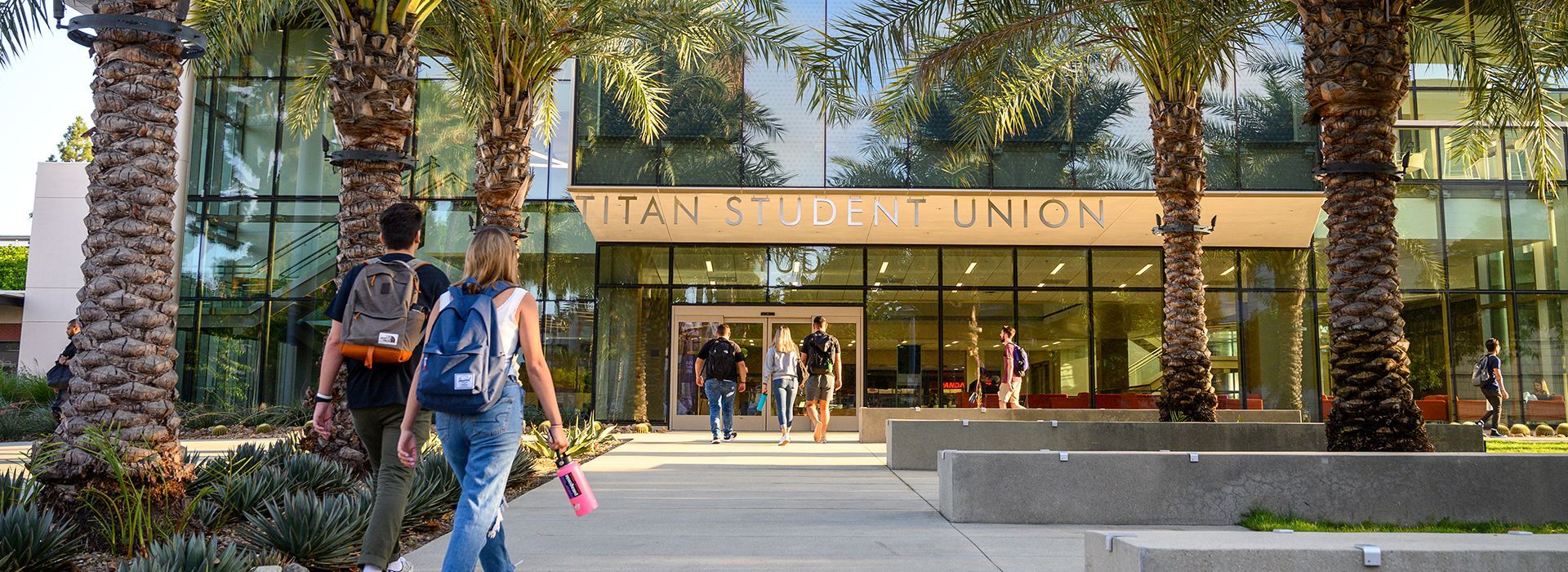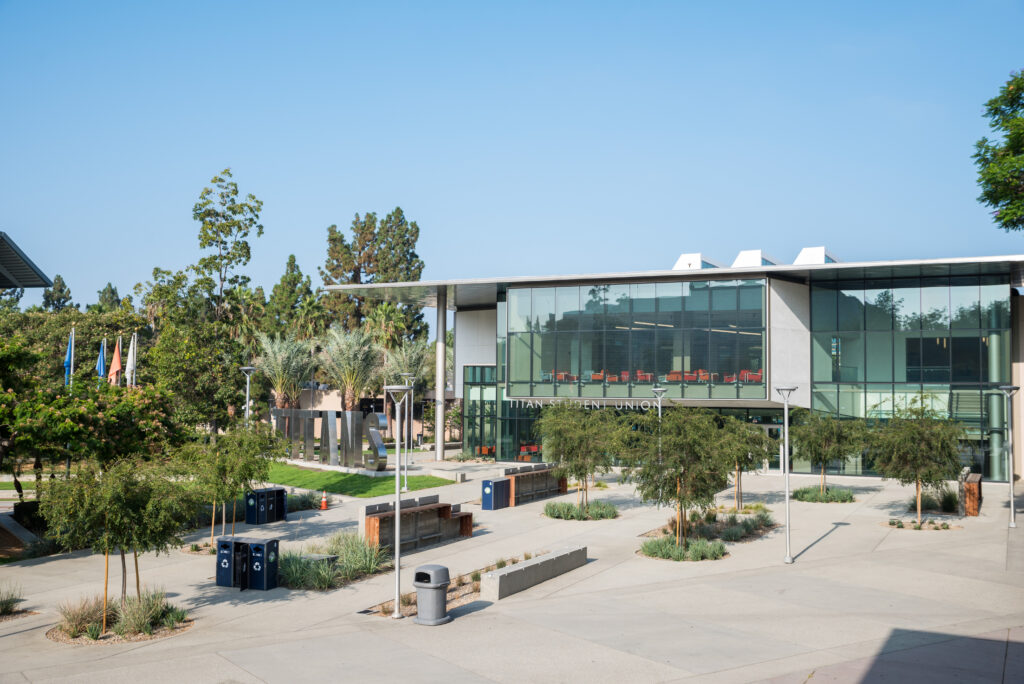
2025-2030 Strategic Plan
The 2025-2030 ASI Strategic Plan was developed collaboratively by ASI student leaders, student employees, and staff. Our Strategic Plan presents a thorough and ambitious road map that will guide our programs, services, and priorities as we strive to elevate the Titan experience for generations to come. This plan is wholly in support of the campus educational mission, reaffirms our far-reaching impact as an organization, and celebrates the Titan Community. ASI commits to the vision statement, mission, values, and goals set in this strategic plan.

ASI enriches the Titan experience and supports the holistic well-being of our campus community at Cal State Fullerton. We offer resources to help overcome challenges, create opportunities, amplify the student voice, and foster an environment where students can fully engage and thrive during their college experience and beyond.
Student Success
ASI values each student’s unique journey and is committed to supporting their overall well-being. We offer co-curricular opportunities and resources that empower students to thrive academically, personally, and professionally.
Belonging
ASI fosters an environment where everyone feels connected and supported. We cultivate a community where individuals are recognized, valued, and empowered to thrive. At ASI, everyone belongs.
Opportunity
ASI cultivates essential skills and confidence for student leaders, student assistants, and professional staff through mentorship, development programs, and data-driven initiatives.
Leadership
ASI provides experiences for Titans to develop and enhance leadership skills. We empower individuals through advocacy, training, and engagement to build lifelong abilities to lead, inspire, and positively influence others.
Foster Student Growth and Well-Being
Objectives
- Expand Holistic Wellness Programs
- Create Career Readiness Opportunities
- Deepen a Culture of Diversity, Equity, Inclusion, and Belonging
Strategies
- Create and enhance programs, services, and resources to address students’ holistic well-being, ensuring they align with students’ preferences by seeking their input on wellness needs.
- Foster engagement and an inclusive campus culture by sharing student stories and testimonials to highlight the benefits of wellness programs.
- Implement career development programs to support students in building leadership and professional competencies by gathering input from them to understand their career readiness needs and professional goals.
- Partner with campus departments to support student development of relevant skills and knowledge.
- Establish Diversity, Equity, Inclusion, and Belonging (DEIB) as foundational principles embedded in all programs, initiatives, and communications, ensuring that DEIB is central to decision-making and operations.
- Provide training, workshops, programs, and events to educate students on DEIB principles and their importance in creating an inclusive community.
- Organize events, resources, and recognition days that celebrate and educate about various cultures, identities, and experiences to build a sense of belonging and awareness.
Progress Towards Goal
- Student participation in and experiences with wellness programs, resources, and activities.
- Student well-being metrics and trends, such as stress levels, mental and physical health, measured through periodic surveys.
- Complete annual evaluations of current and future career readiness program offerings to address student needs.
- Students’ skills and knowledge relevant to their career goals, as evaluated through pre- and post-event assessments. Evaluation of programs, initiatives, and communications efforts that incorporate Diversity, Equity, Inclusion, and Belonging principles.
- Number of students participating in ASI-specific DEIB training, workshops, programs, and events.
- Students’ self-reported sense of belonging and awareness of diverse cultures and identities through pre- and post-assessments.
Goal 2
Provide Support to Enrich Student Employee and Staff Experiences
Objectives
- Advance employee development
- Strengthen recruitment effectiveness and employee retention
- Elevate the employee experience
Strategies
- Offer funding and resources for employees to attend workshops, certifications, conferences, or other learning opportunities to support their career growth, while intentionally gathering employee input to identify their professional development goals and create customized training, mentorship, and resources to meet their needs.
- Create opportunities to provide guidance, foster professional growth, and promote employee collaboration.
Focus on recruiting candidates from diverse backgrounds and specific fields of expertise, utilizing multiple platforms to attract a wide pool of qualified, values-aligned applicants. - Create an engaging and comprehensive onboarding and retention program with clear role expectations, personalized support, and resources to ensure employees feel prepared and welcomed.
- Provide continuous skill enhancement opportunities, resources to advance their careers, and regular check-ins to help employees feel valued and supported in their roles.
- Regularly celebrate employee milestones, achievements, and contributions through events, recognition programs, and spotlight features.
- Seek employee feedback and implement suggestions to improve the work environment and employee satisfaction.
- Create ongoing DEIB training sessions, cultural events, and connection opportunities to ensure employees feel supported, respected, and included based on feedback.
Progress Towards Goal
- Unique participation of employees attending workshops, conferences, certifications, mentorship, or other internal or external learning opportunities.
- Employee participation in professional development opportunities and their satisfaction with having had the opportunity to participate in professional growth and guidance.
- Wide range of recruitment strategies for student and staff positions.
Employee retention rates and satisfaction scores from onboarding check-ins and exit interviews. - Unique participation of employees in skill enhancement opportunities.
- Number of events, recognition programs, and spotlight features celebrating employee achievements.
- Create opportunities for employee feedback and overall employee experience.
- Attendance rates at DEIB training sessions, cultural events, and connection opportunities.
Goal 3
Innovate and Improve ASI Facilities, Programs, and Services
Objectives
- Promote continuous improvement to increase efficiency
- Broaden student-centered spaces, services, and programs
- Ensure accessibility for facilities, programs, and services
Strategies
- Create a feedback-driven culture to evaluate the effectiveness of facilities, programs, and services by establishing a structured approach to assessment and communicating results transparently.
- Utilize feedback methods to gather insights on programs and services, regularly analyze the data to identify areas for improvement, and guide resource distribution, fund allocation, and program adjustments to better meet student needs.
- Encourage innovation, streamline processes, and leverage technology to improve service delivery, optimize resource management, and enhance user experience.
- Expand and introduce new programs and services that cater to the evolving needs of students.
- Evaluate and upgrade existing facilities to meet the needs of current students.
- Develop and promote new resources that support student’s well-being.
- Develop and promote programs, events, and services that ensure in-person accessibility while offering virtual engagement opportunities.
- Update the website, digital platforms, and resources to be more user-friendly and accessible.
- Implement clear and intuitive signage throughout ASI facilities and conduct regular accessibility audits to ensure the accessibility of our spaces, services, and programs.
Progress Towards Goal
- Percentage of programs and services assessed and the frequency of transparent communication of results.
- Data-driven adjustments are made in resource distribution, fund allocation, and program modifications based on effectiveness evaluations.
- Reduction of inefficiencies and increased use of technology to optimize resource utilization and improve user experience.
- Number of new programs and services, and student utilization rates.
- Continuous facility upgrades and student satisfaction scores are favorable toward the upgrades.
- New wellness resources are developed, and student engagement with these resources is higher.
- Number of activities and students participating in hybrid programs,
events, and services, both in-person and virtually. - Use technology and feedback to gauge overall satisfaction and compliance with the accessibility of ASI facilities, programs, and digital platforms.
- Student satisfaction scores regarding the ease of navigating and accessing ASI facilities using accessibility audits for improvements.
Goal 4
Enhance ASI Partnerships and Outreach
Objective
- Increase Awareness and Understanding of ASI
- Foster Partnerships that Support Underrepresented Student Communities
- Broaden Communication and Collaboration with Campus Departments
Strategies
- Establish an annual campus-wide ASI awareness campaign.
- Develop and distribute accessible resources to provide clear information about ASI’s purpose, services, and opportunities for student involvement.
- Conduct a comprehensive needs assessment to identify which student communities are underserved or underrepresented.
- Collaborate with cultural and identity-based organizations and campus departments to develop events and programs that reflect the needs and interests of underrepresented student communities.
- Ensure students of underrepresented communities can engage with ASI.
- Develop a streamlined communication plan that includes sharing ASI’s updates, stories, and opportunities for partnership with key campus departments.
- Create a streamlined collaboration system by setting up a campus partner resource page on the ASI website to facilitate communication and partnership opportunities.
- Strengthen partnerships with campus departments by conducting regular information sessions, integrating ASI resources into their programs, and collaborating on events to enhance outreach.
Progress Toward Goal
- The annual campus-wide ASI awareness campaign has been launched.
- Campus community utilizing and understanding ASI’s purpose, services, and opportunities.
- Underserved or underrepresented student communities are identified using comprehensive needs assessments.
- Student participation and engagement in events and programs developed in collaboration with cultural and identity-based organizations.
- Number of students from underrepresented communities actively engaged in ASI efforts and leadership opportunities.
- Develop a streamlined communication plan that includes sharing ASI’s updates, stories, and opportunities for partnership with key campus departments.
- Create a streamlined collaboration system by setting up a campus partner resource page on the ASI website to facilitate communication and partnership opportunities.
- Strengthen partnerships with campus departments by conducting regular information sessions, integrating ASI resources into their programs, and collaborating on events to enhance outreach.
